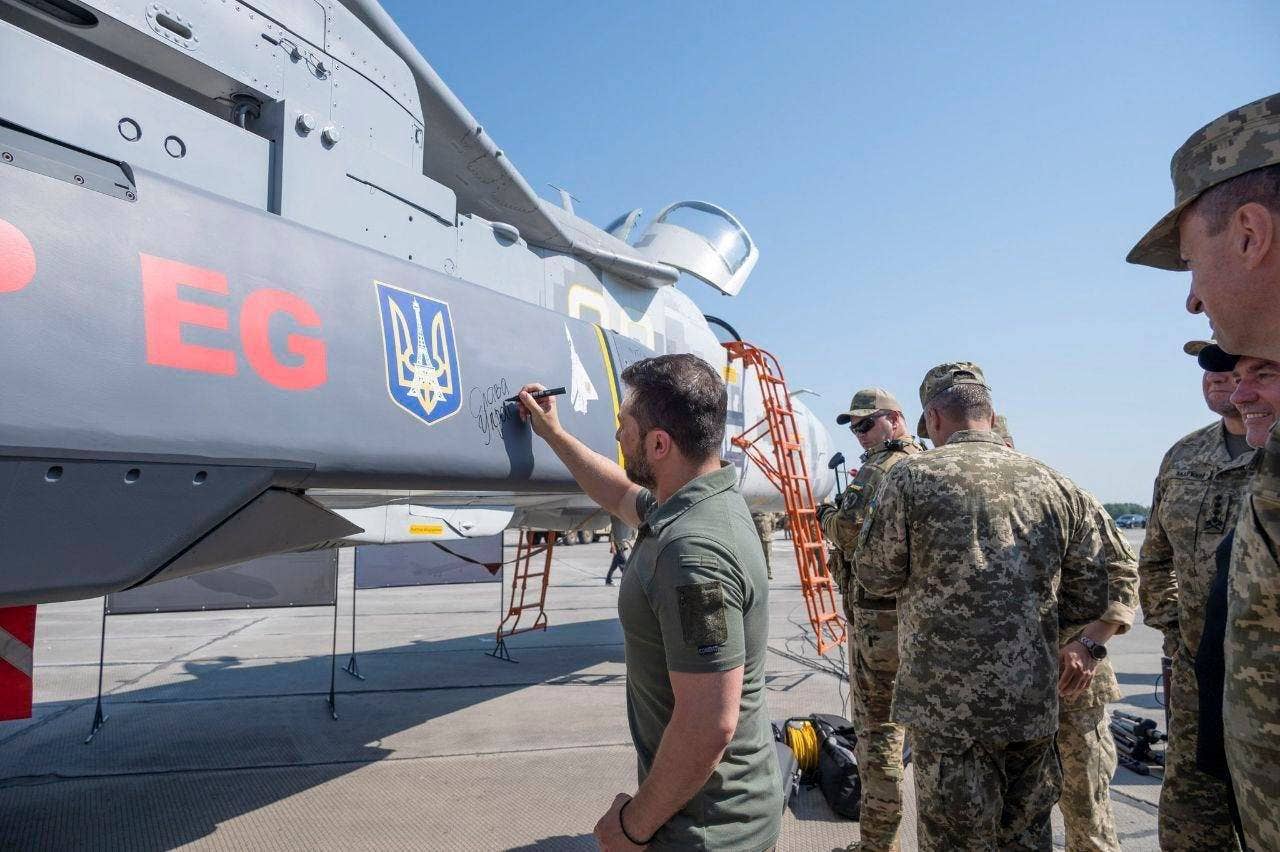In a notable development, on August 6, the President of Ukraine, Volodymyr Zelensky, took to his official social media platforms to share a video showing a French SCALP-EG cruise missile placed beneath the wing of a Su-24 frontline bomber.
With the release of the video, it becomes evident that SCALP-EG, the French version of the UK’s Storm Shadow air-launched cruise missile, has been officially incorporated into Ukraine’s armed forces.
In May, France first expressed its intention to supply Ukraine with SCALP-EG. However, the formal confirmation of this decision was made in mid-July.
The abbreviation SCALP-EG stands for “Système de Croisière Autonome à Longue Portée – Emploi Général,” which translates to “Long Range Autonomous Cruise Missile System – General Purpose” in English.
In the video, President Zelensky can be seen signing a SCALP-EG missile, adorned brightly with the designation in French flag colors and a Ukrainian coat of arms, incorporating the Eiffel Tower.

Additionally, an intriguing emblem featuring a combination of half Mirage 2000 and half Su-24 was observed on the missile. An aviation journalist, Gareth Jennings, noticed this distinctive and unusual logo on the SCALP-EG missile.
The exact meaning behind the merged Mirage-2000 and Su-24M silhouette on the SCALP-EG missile remains open to interpretation.
While some aviation experts have suggested it could indicate a potential future aircraft commitment to Ukraine by France, it could also simply represent two launch platforms—one French (Mirage-2000) and one Ukrainian (Su-24M).
MBDA produces SCALP-EG missiles, which can also be launched from French Rafale aircraft.
Zelensky signs a French-supplied SCALP-EG ALCM mounted on a Ukrainian Su-24. pic.twitter.com/5fiGO5qLvK
— OSINTtechnical (@Osinttechnical) August 6, 2023
Meanwhile, a different photo also emerged on the internet that shows a Ukrainian Su-24M aircraft equipped with a British-supplied Storm Shadow ALCM, featuring the inscription “Storm Shadow” in the UK flag color scheme.
In a separate tweet, Ukraine’s Defense Ministry claimed that the Storm Shadow had damaged bridges in Chongar and Henichesk.
These bridges serve as vital routes for transporting supplies and personnel from occupied Crimea to Russian forces stationed along the frontlines to the north.
SCALP-EG/Storm Shadow For Ukraine
So far, British-supplied Storm Shadow missiles have proven highly effective in conducting precise strikes on critical Russian targets. With the assistance of this missile, the Ukrainian Air Force has transformed its aging Sukhoi Su-24 bombers into powerful deep-strike systems.
In response, Russia has attempted to neutralize these missiles and their launch platforms, particularly the Su-24 Fencer, of which Ukraine possesses a limited operational number.
However, Russia’s long-range missile and drone strikes have been unsuccessful in preventing their use. Yet, a major apprehension revolves around the limited availability of the Storm Shadow missile.
Thus, the introduction of the French variant becomes crucial for Ukraine. It significantly enhances Ukraine’s arsenal of these valuable munitions at a time when they are greatly needed.
Fabian Hoffmann, a defense expert based in Oslo, highlights a crucial observation regarding Ukraine’s Storm Shadow/SCALP-EG missile supply. Before the war, France and the UK possessed around 1,250-1,400 of these missiles.
Huffman initially estimated a donation rate of 10-20% (140-280 missiles) for Ukraine’s acquisition of Storm Shadow/SCALP-EG missiles.
However, they have received or been promised a larger quantity based on Ukraine’s consumption rate. Hoffmann added that approximately 150-200 of these missiles had sustained Ukraine’s military operations for about 2.5 months.
The UK has likely made a significant contribution from its Storm Shadow arsenal to support Ukraine’s efforts during the summer offensive. Moreover, France’s delivery of SCALP-EG missiles offers an additional limited buffer.
However, Hoffmann expressed concern about the future, particularly in fall/winter, if no other nations step forward to provide Long-Range Strike (LRS) capabilities, and Ukraine’s current rate of missile consumption continues.
The limited supply of LRS munitions might become problematic in sustaining Ukraine’s military operations during the colder months.
Ukraine has also sought to acquire Germany’s similar Taurus missile. Their initial request for Taurus missiles was made in May, coinciding with their preparations for the long-awaited counteroffensive against Russian forces, which commenced the following month.
However, as of now, Germany has displayed reluctance in providing this missile, officially confirming in July that the Taurus cruise missile is not currently under consideration for export to Ukraine.
Nonetheless, acquiring French missiles creates the potential for expanded strikes in the ongoing conflict.
As Kyiv seeks to accelerate its slow-going counteroffensive efforts, this enhanced capability could serve as a crucial asset in intensifying military actions against Russian forces.
- Contact the author at ashishmichel(at)gmail.com
- Follow EurAsian Times on Google News